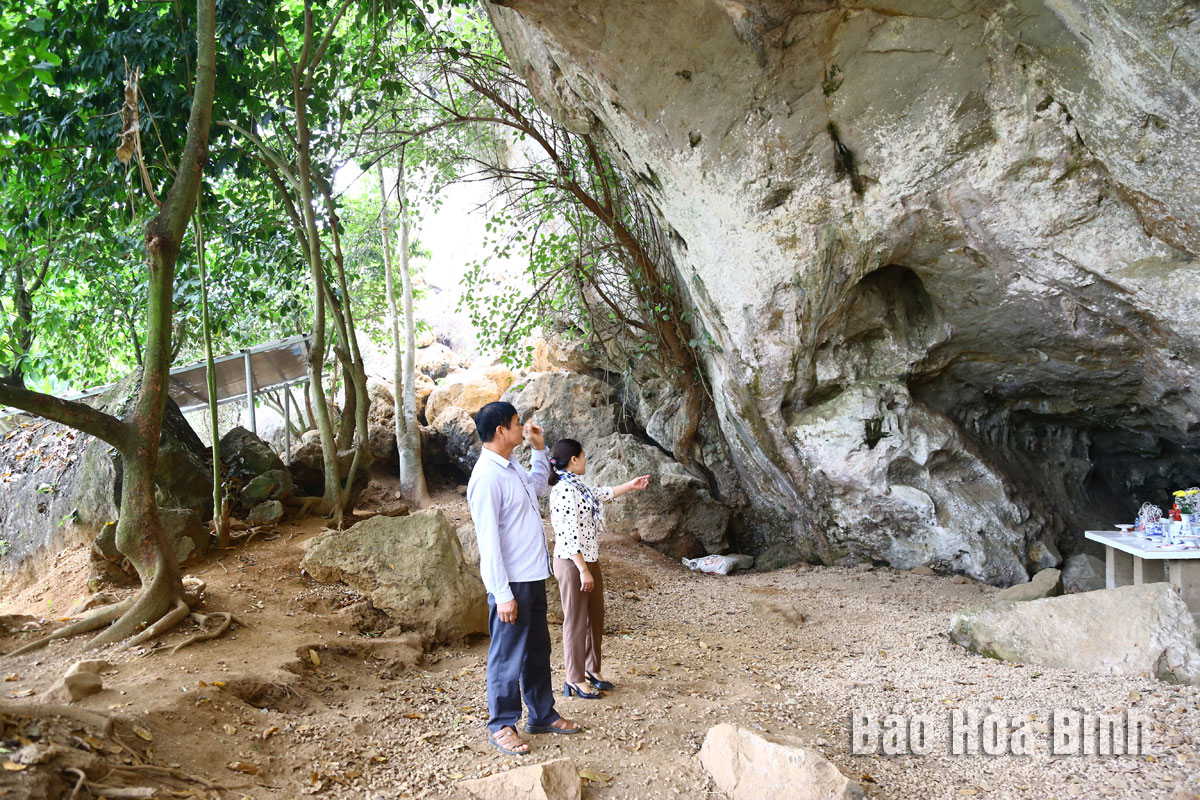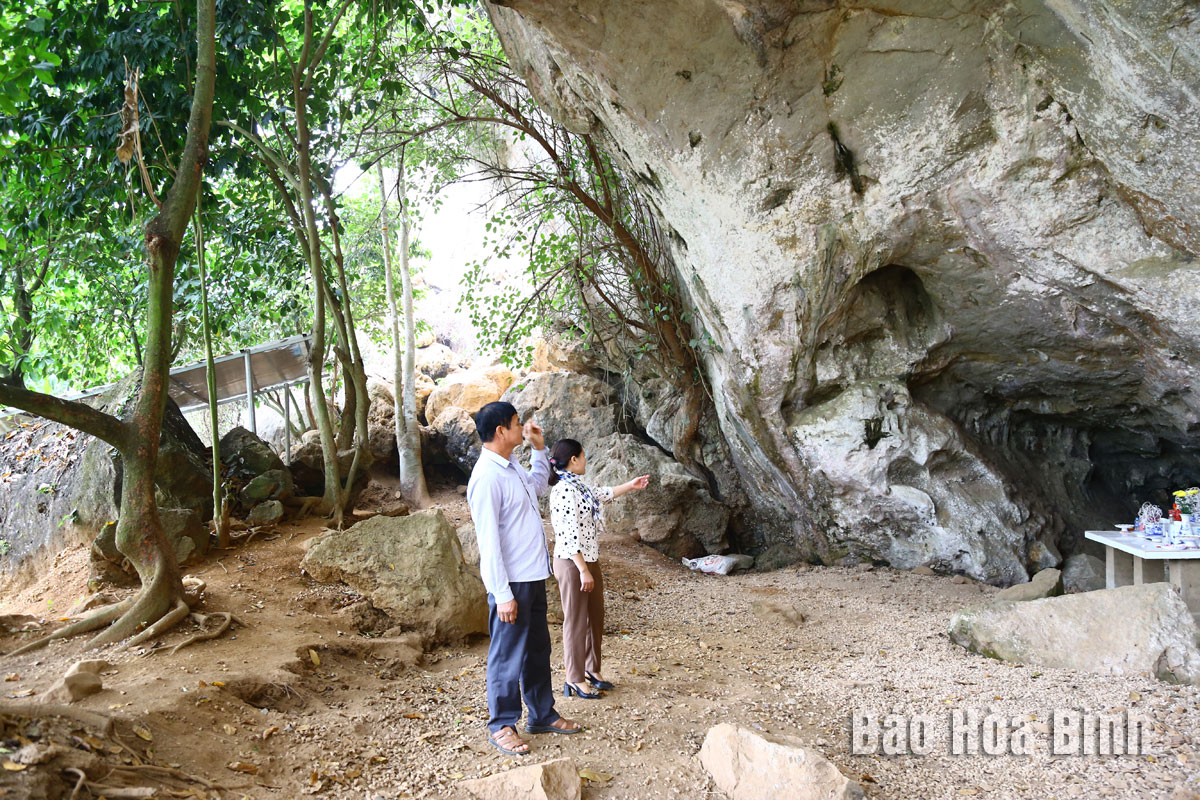
Holding unique values representing the world-famous Hoa Binh Civilisation, the archaeological sites of Trai Hamlet Cave and Vanh Village Stone Shelter in Lac Son district were recognised as special national relic sites in July.
Local residents have paid attention to protecting
natural landscape and environment around special national relic site of Vanh
Village Stone Shelter in Yen Phu commune, Lac Son district.
Exploring
Trai Hamlet Cave, Vanh Village Stone Shelter
Trai Hamlet Cave is located on a separate
limestone mountain, 15m above a nearby valley. It is more than 13m deep and has
an entrance 8m wide and 10m high. It contains food traces of early humans,
mainly stream and mountain snails. Statistics show that there are more than
30,000 shells per cubic metre of sediment inside this cave. Archaeologists have
found a substantial number of animal bone pieces here. Analyses indicate that
these are bones of animals living in the surrounding environment that early
humans caught for food. Rice husks and some half-burned grains have also been
discovered at a depth of 0 - 80cm underground, and they could belong to later
periods. This cave was listed as a national historical relic site in 2001.
Not far from Trai Hamlet Cave, Vanh Village
Stone Shelter is located at the foot of Da Trang (White Stone) Mountain in Vanh
village of Yen Phu commune. It is a relatively large stone shelter which is 18m
deep and has a 30m-wide entrance. It is about 5m higher than the surrounding
valley. The site was discovered and excavated by M. Colani in 1929 and also
named by the French archaeologist. Excavations at this place have revealed a
3.7m-thick cultural layer that contains mainly snails, clay, ashes, and mollusc
shells. Stone objects, human and animal bone pieces, horns, ceramic items,
stoves, and snail shells have also been found here. The shelter was named a
national historical relic site in 2003.
Promoting
relic sites’ values
Given their precious values, the two national
archaeological relic sites were recognised as special ones on July 18, 2024.
Bui Van Hung, head of the culture and
information division of Lac Son district, said that home to the two
archaeological relic sites typical for the prehistoric Hoa Binh Civilisation,
Lac Son has continually paid attention to the management, protection,
preservation, and promotion of the sites’ values. It is stepping up
communications about the places’ significance and values among the entire local
population so as to attract the public’s support for protecting the surrounding
landscape and environment. Tourism, learning, and scientific research
activities connected with the sites are also being promoted.
In the time ahead, to bring into full play the
values of these two special national relic sites, local authorities will
continue to seriously carry out management and protection activities in line
with the Law on Cultural Heritage, devise appropriate policies to encourage and
create conditions for people and businesses to engage in relic protection and
tourism development, and build new roads to connect arteries with the two
sites.
Additionally, the district will propose relic
management and rehabilitation measures to higher-level authorities in an effort
to become a destination on the tourism maps of Hoa Binh province, the region, and
the country, he added.
With an increasingly vibrant and widespread emulation movement aimed at building cultured residential areas and cultured families, Yen Thuy District has been making steady progress toward improving both the material and spiritual well-being of its people, while fostering a civilized, prosperous, beautiful, and progressive community.
Once lacking recreational spaces and community facilities, Residential Group 2 in Quynh Lam Ward (Hoa Binh City) has recently received attention for the construction of a new, spacious, and fully equipped cultural house. The project followed the model of state support combined with public contributions in both labor and funding.
The "All people unite to build cultural life" movement, which has been effectively integrated with Kim Boi district’s socio-economic development goals, is fostering a lively spirit of emulation across local residential areas, hamlets, villages, public agencies, and enterprises. In addition, through the initiative, traditional cultural values are being preserved and promoted, while community solidarity and mutual support in poverty reduction and economic development are being strengthened.
A working delegation of the Hoa Binh provincial People’s Committee led by its Permanent Vice Chairman Nguyen Van Toan on June 11 inspected the progress of a project to build the Mo Muong Cultural Heritage Conservation Space linked to tourism services in Hop Phong commune, Cao Phong district.
Born and growing in the heroic land of Muong Dong, Dinh Thi Kieu Dung, a resident in Bo town of Kim Boi district, in her childhood was nurtured by the sweet lullabies of her grandmother and mother. These melodies deeply imprinted on her soul, becoming an inseparable part of her love for her ethnic group's culture. For over 20 years, this love for her hometown has driven Dung to research, collect, and pass down the cultural values of the Muong people to future generations.
In the final days of May, the Ethnic Art Troupe of Hoa Binh Province organized performances to serve the people in remote, mountainous, and particularly disadvantaged areas within the province. These were not just ordinary artistic shows, but they were the meaningful journeys aimed at spreading cultural values, enhancing the spiritual life of the people and contributing to the preservation of ethnic minority cultural identities.



